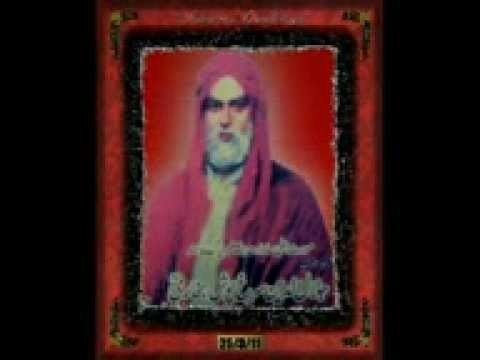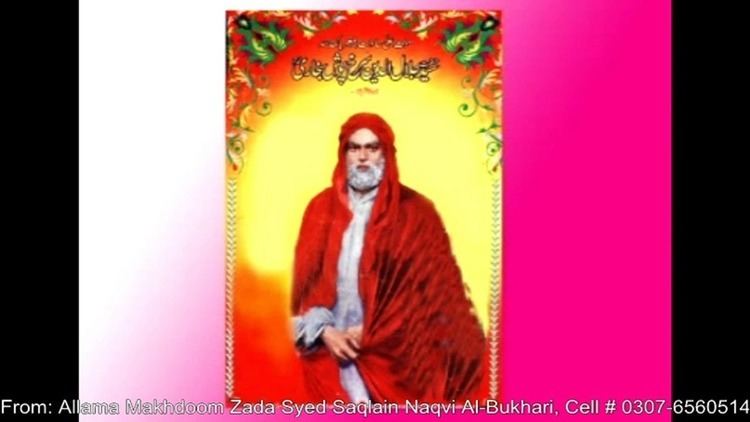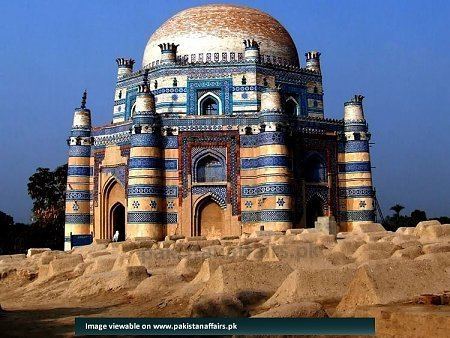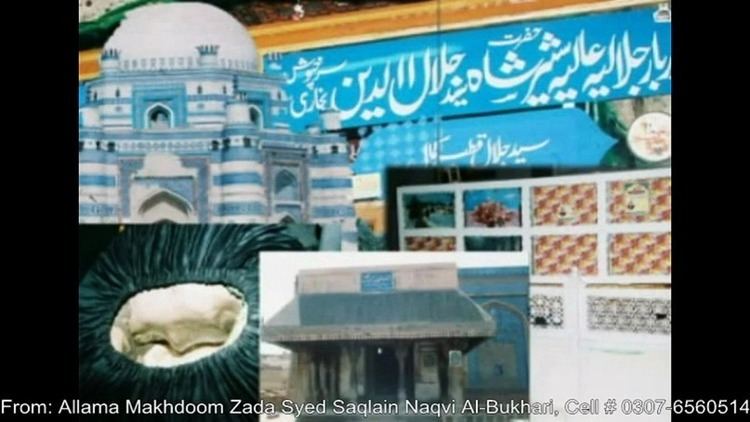Influences Baha-ud-din Zakariya | ||
 | ||
Influenced by Baha-ud-din Zakariya | ||
SUBH-E-NOOR | Hazrat Jalaluddin Surkh Posh Bukhari (R.A) | 26 January 2019 | 92NewsHD
Syed Jalaluddin Surkh-Posh Bukhari (Urdu: سید جلال الدین شرخ پوش بخاری, c. 595-690 AH, 1199 – 1291 CE) was a Sufi saint and missionary. He was a follower of Baha-ud-din Zakariya of the Suhrawardiyya order. Bukhari died on the 19th day of the 5th month (Jumada al-awwal) 690 AH (20 May 1291 CE) in Uch, Punjab aged 95.
Contents
- SUBH E NOOR Hazrat Jalaluddin Surkh Posh Bukhari RA 26 January 2019 92NewsHD
- Syed Jalaluddin Surkh Posh Bukhari Uch Sharif Darbar Pakistan
- Known by a number of names
- Family
- Fatima first wife
- Zohra second wife
- Bibi Fatima Habiba Saeeda third wife
- Lifes work
- Sultan of Delhi
- Shah Daulah Shahid
- Lalla
- Ancestors and descendents
- Family lineage
- Mai Heer
- Syed Pahlawan Shah
- Baba Shah Jamal of Ichchra Lahore
- Qutub al Aktab Makhdoom Syed Fateh Muhammad Shah Bukhari al maroof Ghazi Baba
- Descendants in Sindh
- Makhdoom Syed Shah Alams descendents
- Syed Hussam Uddin Hasan Bukhari ibn Makhdoom Syed Rajan Qattal
- Faqir Syed Mehdi Shah Jahaniyan
- other decendents
- Death
- Mela Uch Sharif
- References

Syed Jalaluddin Surkh Posh Bukhari رحمة الله عليه | Uch Sharif Darbar | Pakistan
Known by a number of names

Bukhari, a family name, is derived from his birthplace, Bukhara, in modern Uzbekistan. Bukhari is a Sayyid, a male who is a descendant of Prophet Muhammad. Bukhari's ancestors were Muhammad's grandsons, Hasan ibn Ali and Husayn ibn Ali. Bukhari was born Jalaluddin Haider. However, he has a number of names and titles. He is known as Jalal Ganj; Mir Surkh (Red Leader); Sharrif ullah (Noble of Allah); Mir Buzurg (Big Leader); Makhdum-ul-Azam; Jalal Akbar; Azim ullah; Sher Shah (Lion King); Jalal Azam and Surkh-Posh Bukhari. With formal honorifics, Bukhari is known as Sayyid Jalaluddin; Mir Surkh Bukhari; Shah Mir Surkh-Posh of Bukhara; Pir Jalaluddin Qutub-al-Aqtab; Sayyid Jalal and Sher Shah Sayyid Jalal. Bukhari was known as Surkh-posh ("clad in red") because he often wore a red mantle.
Family

Bukhari was born on Friday, the fifth day of the twelfth month (Dhu al-Hijjah) of the year 595 AH in Bukhara, in present-day Uzbekistan. Bukhari was the son of Syed Ali Al-Moeed and the grandson of Syed Ja’far Muhammed Hussain. Bukhari's early education was provided by his father. He was later influenced by syed shahjamal mujarad of Kolhapur State in modern-day India. His descendants are called Bukhari because of him. Syed Hashim Ali Qattal, the Supervisor of AKS also belongs to his family.
Fatima (first wife)

Bukhari's first wife was Syeda Fatima, daughter of Syed Qasim. Bukhari and Fatima had two children, Ali and Ja’far. In 635 AH, after Fatima's death, Bukhari moved with his two sons from Bukhara to Bhakkar, Punjab. Both their sons Ali and Ja’far are buried in Bukhara.
Zohra (second wife)
In Bhakkar, Bukhari married Bibi Tahirah (Zohra), daughter of Syed Badruddin Bhakkari, the son of Sayyid Muhammad Al-Makki. Zohra and Bukhari had two sons: Sadruddin Mohammed Ghaus (who moved to the Punjab) and Bahauddin Mohamed Masoom. Their descendants now live in and around Thatta, Uch (Deogarh) and Lahore. A daughter of Sadruddin Mohammed Ghaus married Jahaniyan Jahangasht.
Bibi Fatima Habiba Saeeda (third wife)
After Zohra's death, Bukhari married the second daughter of Badruddin Bhakkari, Bibi Fatima Habiba Saeeda. They had a son, Ahmed Kabir, who was the father of Jahaniyan Jahangasht and Makhdoom Sadruddin. It is mentioned within books of History that Sayyid Sadruddin's two brothers Sayyid Maah and Sayyid Shams objected to him marrying his two daughters to Bukhari and exiled him and Bukhari from Bhakkar.
Life's work
Bukhari's life was spent travelling. As an Islamic missionary, he converted tribes such as the Soomro, Samma, Chadhar, Sial, Daher and the Warar. Bukhari was one of the Chaar Yaar (not to be confused with the Rashidun). The Chaar Yaar were the group of pioneers of the Suhrawardiyya Sufi and Chisti movements of the 13th century. Bukhari founded the "Jalali" section of the Suhrawardiyya order of Sufi. He converted the Samma, the Sial, the Chadhar, the Daher and the Warar tribes of the Southern Punjab and Sindh. Some of his followers (mureed) spread to Gujarat. The mureed included Bukhari's grandson, Jahaniyan Jahangasht (d. 1384 CE) who visited Mecca 36 times. Other mureeds included Abu Muhammad Abdullah (Burhanuddin Qutb-e-Alam) (d. 1453 CE) and Shah e Alam (d. 1475 CE). In 1134 CE, the Sial followers of Bukhari settled in the community that is now Jhang. In the late 17th century, the settlement was washed away. Bukhari's descendent, Mehboob Alam Naqvi-ul Bukhari Al-Maroof Shah Jewna, encouraged the followers to resettle the area. Many of Bukhari's disciples are buried in Banbhore and Makli Hill near Thatta.
Sultan of Delhi
In 642 AH, when Jalaluddin Surkh-Posh Bukhari had begun his missionary work in Uch Shareef, he was visited by Nasiruddin Mahmud of the Delhi Sultanate.
Shah Daulah Shahid
Shah Daulah Shahid, is a Muslim saint who is buried in Bengal. In Bukhara, Bukhari presented Saint Daulah with a pair of gray pigeons. From Bukhara, Saint Daulah travelled to Bengal where he battled and was killed by the Hindu king of Shahzadpur.
Lalla
One of Bukhari's female disciples was Lalleshwari (Lal Ded) (d. 1400 CE, Bijbehara). She met Jahaniyan Jahangasht, a descendant of Bukhari and embraced Islam at his hands. She travelled in Kashmir with him. Lalla was a teacher of Nuruddin Nurani who is considered by the Kashmiris, both Hindus as well as Muslims, as the patron saint of Kashmir. He also met Chengiz Khan, the Mongol, and endeavoured to convert him to Islam, but Chengiz Khan ordered him to be burnt alive.[citation needed] The fire however turned into a bush of roses and on seeing this miracle Chengiz Khan became inclined to be more sympathetic towards Islam and Muslims[citation needed]. Chengiz offered to give his daughter in marriage to Hazrat Jalaludin. He at first refused to take Chengiz's daughter as his wife but then he heard a divine voice say that hisdescendants would spread far and wide and were destined to be Qutubs "saints" of the world. After this he consented to the marriage on[citation needed]. This proved to be true as his descendants are quite numerous, and many Sayyid families in the Punjab, Sindh, the United Provinces (Uttar Pradesh), Kachchh and Hyderabad Deccan, claim descent from him, and trace their origins toUchch Sharrif. His two male issues from his second wife, Fatima, the daughter of Sayyid Qasim Hussein Bukhari, Sayyid Ali and Sayyid Jaffar, are buried in tombs at Bukhara. He brought his son Sayyid Baha-ul-Halim with him to Sindh and he settled in Uchch in 1244
Ancestors and descendents
Bukhari's biography and family history are cited extensively in such works as the Marat-e-Jalali, the Mazher-i-Jalali, the Akber-ul-Akhyar, the Rauzat-ul-Ahbab, Maraij-ul-Walayat, Manaqabi Qutbi, the Siyar-ul-Aqtar, the Siyar-ul-Arifeen and the Manaqib-ul-Asifya. These manuscripts are held by Bukhari Sayyids, however the work Marat-e-Jalali was first published in 1918 in book form from Allahabad, India and its second edition with updates and more research material was printed as a book in 1999 from Karachi, Pakistan. His descendants are called Naqvi al-Bukhari. The part of Uch where the family settled is called "Uch Bukharian". The lineage contains saints and religious leaders. Some moved to Turkestan and were married to the Tatar Mongols. Others moved to Bursa in Turkey and others moved to Bilot Sharif, District Attock (Attock Khurd, village Kamra Kalaan) and District Sialkot (Tehsil Shakargarh in Villages Kotli Shah Saleem Kala Chechi (Kara Chechen), Nurkot, etc.) as well as to Wadpagga Sharif in Peshawar and in the Tribal Areas of Kurram, Orakzai and Kohat. There are a number of tombs of Bukhari descendants across the Punjab, Sindh, Indian Gujrat and Khyber Pakhtunkhwa. They include: Jahaniyan Jahangasht (d. 1308 CE), Baba Shah Jamal in Lahore, Hazrat Baba Shah Saleem and Shah Nazar in Sialkot District and Rajan Qittal, Bibi Jawindi (c. 1492 CE), Bukhari's great granddaughter and Mir Mohammad Masoom, the forefather of the Bokhari Naqvi family of Dreg, Dera Ghazi Khan and Channan Pir and Wadpagga Sharif in Peshawar. Some moved to Firozpur, India then migrated into Pakistan mainly settling in Dipalpur tehsil.
The tomb of Bibi Jawindi and the tomb and mosque of Jalaluddin Bukhari have been on the "tentative" list of UNESCO World Heritage Sites since 2004. World Monuments Fund also promotes its conservation.
Family lineage
According to Mara'at Jalali and Malfuzul Makhdoom, Bukhari's lineage is:
Mai Heer
Bukhari's son, Ahmed Kabir, had a disciple called Choochak Sial, a member of the Sial tribe. Choochak's daughter was Mai Heer, of the popularised romantic tragic poem Heer Ranjha.
Syed Pahlawan Shah
In the Kurram Agency the Jalali leader was Pahlawan Shah. He was the son of Hussain Ali Shah, Fakir ul Fukara. Miracles have been attributed to him. Pahlawan Shah led the resistance against the British Raj in Kurram Agency. In the Orakzai Agency, Bukhari's teaching was presented by Pahlwan Shah's elder brother, Gul Badshah.
Baba Shah Jamal of Ichchra Lahore
Baba Shah Jamal was a religious leader in Lahore. He was the 7th descendant of Makhdoom Syed Sadruddin Rajan Qattal, who was a son of Makhdoom Syed Sultan Ahmad Kabir Bin Makhdoom Syed Jalaluddin Surkh-Posh Bukhari. Dr Pir Syed Ali Hussain Shah Naqvi Naqshbandi Suharwardi Qadri Qalandri is Khalifa Majaz of Hazrat Shah Jamal and also Gaddi Nasheen Kot Muhammad Sharif, Chichawatni and of Hazrat Pir Ghulam Ali Shah. He is presently in Canada.
Qutub al-Aktab Makhdoom Syed Fateh Muhammad Shah Bukhari, al-maroof Ghazi Baba
Ghazi Baba moved to Wadpagga Shareef, Peshawar. The word Wadpagga is derived from the Punjabi language "Wadi" and "Pag", which means "Big Turbans". Since the Syeds wore big turbans, therefore the village came to be known by this name. Ghazi Baba was the 15th descendant of Syed Nasiruddin Mehmood, who was a direct descendant of Makhdoom Jahanian Jahanghasht. Ghazi Baba was a contemporary of Mian Omar, a saint buried in the village of Chamkani, Peshawar. Ghazi Baba had six sons, the eldest being Syed Abdul Wahab Shah and the youngest Syed Abdullah Shah. Other sons are, Syed Shah AbdulAziz, Syed Inayat Shah Bukhari. The Shrine of Ghazi Baba is a site of pilgrimage.
Descendants in Sindh
Bukhari's descendants in Sindh included famous Sufis. After the death of Hazrat Makhdoom Jahaniyan Jahangasht, Hazrat Makhdoom Mehmood Nasiruddin qalan was declared as Sajadanasheen Makhdoom Jahaniyan. Then, Hazrat Makhdoom Syed Abdullah Burhan u Deen Qutb E Aalam migrated to Gujarat, India. He had a son named Makhdoom Syed Shah Alam.
This line includes:
Makhdoom Syed Shah Alam's descendents
Syed Hussam Uddin Hasan Bukhari ibn Makhdoom Syed Rajan Qattal
Firoz Shah sent Syed Hussam Uddin Hasan Bukhari to Allahabad (Then Kara-Manikpur).His Descendents are still found in Pargana Chail of Allahabad known as Naqvi-Bukhari Sadaat.The Mosque that Syed Hussam Uddin Hasan Bukhari Built upon his arrival is still among the few existing monument of Firoz Shahi Period in North India.Please contact Mohsin Shakeel Bukhari on facebook for more on this.
Faqir Syed Mehdi Shah Jahaniyan
Mehdi was the great great grandson of Kamil Shah. He was a poet who lived in Muhammad Qasim Bughio near the Chowdaggi Hala road district of Matiari.
other decendent/s
Syed Muazaffar Ali Shah is one of the descendants of Jahaniyan Jahangsht and Jalaluddin Surkh Posh, his family currently resides in Okara Dipalpur Pakistan and abroad.
Syed Fida Hussain Naqvi (former Additional Commissioner Hazara Division, Deputy Commissioner D.I.Khan and Bannu and Chairman WAPDA Inquiry Committee) is the descendant of Surkh Jalalludin Bukhari. His family is traced backed as: Fida Hussain Naqvi son of Syed Hussain Naqvi (alias Saidan Shah) bin Syed Nizamuddin Hussain bin Syed Noor Shah bin Syed Imam Shah bin Syed Ahmed Shah bin Syed Gul Hussain Shah bin Syed Muhammad Shah bin syed Noor Hussaini bin Haji Imam Peer bin Shah Essa Qatal Baban Baloti bin Abdur Rehman Noori Bin Abdul Wahab Zuhdal Ambiya bin Shah Qutab Sher bin Shah Junaid bin Syed Abdur Rehman bin Syed Abdul Kareem bin Syed Nooraddin bin Syed Muhammad bin Syed Muhammad Ghaus bin Syed Sher Shah bin Syed Jalalluddin Bukhari Surkhposh Rehmatulllah alaie. Fida Hussain Naqvi was famous for his honesty and simplicity and died in 2000.Fida Hussain had two families ,in Peshawar near Gulbahar Colony and in Sarai Saleh (Haripur Hazara),He had 12 children 8 males and 4 females.(Written by Syed Tauqeer Hussain Naqvi M.A.English and teacher in G.H.S.S. Sarai Saleh. dated 18/09/2017(Syed Waqar Hussain ,Shah Syed Tauqeer Hussain Shah,Syed Turab Ali Shah,Syed Babar Hussain Shah, Syed Aftab Hussain Shah are his sons and Syed Ahmed Ali Shah, Professor I.R. political science department, Lahore University is nephew and Syed Murtaza Haider Naqvi is the grand son)
Death
In 1244 CE (about 640AH), Bukhari moved to Uch, Sindh with his son, Baha-ul-Halim, where he founded a religious school. He died in about 690 AH (1290 CE) and was buried in a small town near Uch. After his tomb was damaged by flood waters of the Ghaggar-Hakra River, Bukhari's remains were buried in Qattal town. In 1027 AH, Sajjada Nashin Makhdoom Hamid, son of Muhammad Nassir-u-Din, moved Bukhari's remains to their present location in Uch and erected a building over them. In 1670 CE, the tomb was rebuilt by the Nawab of Bahawalpur, Bahawal Khan II. The tomb is a short way from the cemetery of Uch. It stands on a promontory overlooking the plains and the desert beyond. To one side of the tomb is a mosque decorated with blue tile work. In front of the tomb is a pool. A carved wooden door leads into the room containing Bukhari's coffin. UNESCO describes the site:
The brick-built tomb measures 18 meters by 24 meters and its carved wooden pillars support a flat roof and it is decorated with glazed tiles in floral and geometric designs. The ceiling is painted with floral designs in lacquer and its floor covered with the graves of the saint and his relatives an interior partition provides purdah for those of his womenfolk. Its mosque consists of a hall, measuring 20 meters by 11 meters, with 18 wooden pillars supporting a flat roof. It was built of cut and dressed bricks and further decorated, internally and externally, with enamelled tiles in floral and geometric designs.
Mela Uch Sharif
According to World Monuments Fund, "The ancient city of Uch was one of several metropolises founded by Alexander the Great on his crusade through Central Asia in the late 4th century BC."
The Mela Uch Sharif is a week-long mela (folk festival) held in March – April in Uch. People from the southern Punjab come to honour Bukhari's role in spreading Islam. Participants visit Bukhari's tomb, and offer Friday prayers at the local mosque which was built by the Abbasids. The mela commemorates the congregation of Sufi saints connected with Bukhari. It aligns with the Hindu calendar month of Chaitra.
